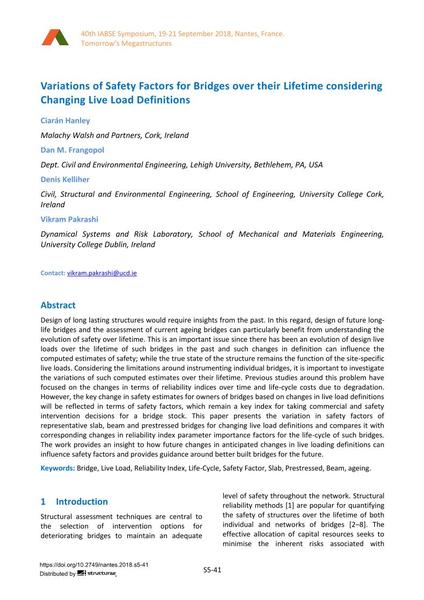Variations of Safety Factors for Bridges over their Lifetime considering Changing Live Load Definitions

|
|
|||||||||||
Bibliografische Angaben
| Autor(en): |
Ciarán Hanley
(Malachy Walsh and Partners, Cork, Ireland)
Dan M. Frangopol (Dept. Civil and Environmental Engineering, Lehigh University, Bethlehem, PA, USA) Denis Kelliher (Civil, Structural and Environmental Engineering, School of Engineering, University College Cork, Ireland) Vikram Pakrashi (Dynamical Systems and Risk Laboratory, School of Mechanical and Materials Engineering, University College Dublin, Ireland) |
||||
|---|---|---|---|---|---|
| Medium: | Tagungsbeitrag | ||||
| Sprache(n): | Englisch | ||||
| Tagung: | IABSE Symposium: Tomorrow’s Megastructures, Nantes, France, 19-21 September 2018 | ||||
| Veröffentlicht in: | IABSE Symposium Nantes 2018 | ||||
|
|||||
| Seite(n): | S5-41 | ||||
| Anzahl der Seiten (im PDF): | 8 | ||||
| DOI: | 10.2749/nantes.2018.s5-41 | ||||
| Abstrakt: |
Design of long lasting structures would require insights from the past. In this regard, design of future long- life bridges and the assessment of current ageing bridges can particularly benefit from understanding the evolution of safety over lifetime. This is an important issue since there has been an evolution of design live loads over the lifetime of such bridges in the past and such changes in definition can influence the computed estimates of safety; while the true state of the structure remains the function of the site-specific live loads. Considering the limitations around instrumenting individual bridges, it is important to investigate the variations of such computed estimates over their lifetime. Previous studies around this problem have focused on the changes in terms of reliability indices over time and life-cycle costs due to degradation. However, the key change in safety estimates for owners of bridges based on changes in live load definitions will be reflected in terms of safety factors, which remain a key index for taking commercial and safety intervention decisions for a bridge stock. This paper presents the variation in safety factors of representative slab, beam and prestressed bridges for changing live load definitions and compares it with corresponding changes in reliability index parameter importance factors for the life-cycle of such bridges. The work provides an insight to how future changes in anticipated changes in live loading definitions can influence safety factors and provides guidance around better built bridges for the future. |
||||
| Stichwörter: |
Brücke Biegeträger Lebenszyklus Zuverlässigkeitsindex
|
||||
